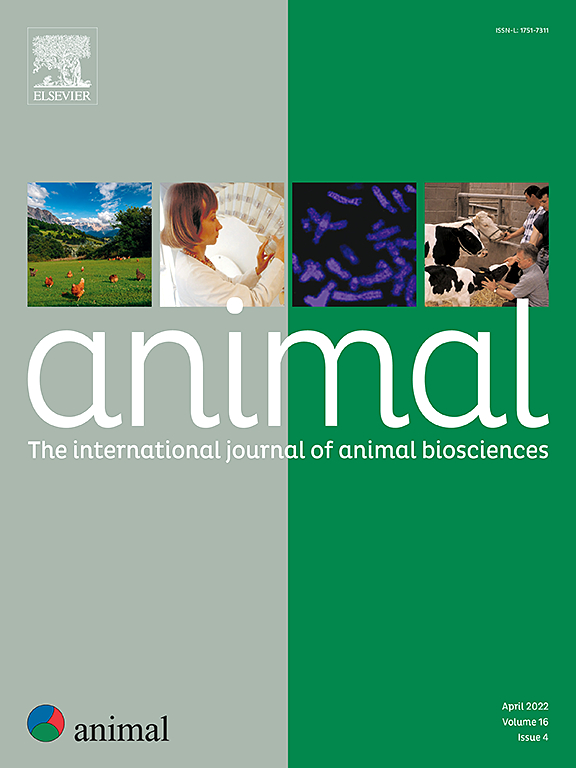Partially replacing baleage with grazed forage canola in a component feeding system: Effects on production performance, enteric methane emissions, and nutrient utilization in dairy cows
IF 4.2
2区 农林科学
Q1 AGRICULTURE, DAIRY & ANIMAL SCIENCE
引用次数: 0
Abstract
Forage canola is an annual crop with the potential to extend the grazing season and reduce enteric CH4 emissions due to its low fiber concentration. We aimed to evaluate the effect of partially replacing alfalfa-grass mix baleage with grazed forage canola on production performance, ruminal fermentation, enteric CH4 emissions, and nutrient utilization in dairy cows. Twelve multiparous Jersey cows averaging 131 ± 63 days in milk (DIM) and 462 ± 26 kg of BW and 6 primiparous Jersey cows averaging 175 ± 64 DIM and 418 ± 38 kg of BW were used in a randomized complete block design study. Treatments were formulated (DM basis) as follows: (1) 60% alfalfa-grass mix baleage, 38% concentrate pellet, and 2% roasted soybean (control = CON), and (2) 30% alfalfa-grass mix baleage, 30% grazed forage canola, 38% concentrate pellet, and 2% roasted soybean (forage canola = CAN). Cows in the CAN treatment had access to the forage canola pasture after the afternoon milking. The experiment consisted of a 2-week covariate period and a 5-week experimental period with samples collected during weeks 3 and 5. Although DM intake was greater in cows fed CAN than CON, milk yield was lowest in CAN. Milk true protein concentration, milk lactose yield, feed efficiency (milk yield/DM intake), milk N efficiency (milk N yield/N intake), ruminal pH and molar proportion of propionate, milk proportion of n-6 fatty acids, and enteric CH4 emissions were all lower in CAN versus CON. Treatment−by−week interactions were observed for the concentrations of milk urea N, plasma urea N, and ruminal NH3-N, apparent total-tract digestibilities of DM and organic matter, urinary excretion of urea N (g/day and % of urinary N excretion), ruminal molar proportion of butyrate, and milk proportion of n-3 fatty acids. For all these interactions, values were greater in CAN versus CON, but the magnitude of treatment differences varied from week 3 to week 5. A treatment by week interaction was also detected for the ruminal molar proportion of acetate, which decreased more pronouncedly in CAN than CON diet from week 3 to week 5. Intake of digestible energy and metabolizable energy (ME), and the efficiency of converting digestible energy into ME were greater in CAN than CON. Contrarily, the efficiency of converting ME into milk energy was lower in CAN versus CON cows. In brief, greater ME intake and nutrient digestibility in CAN compared with CON did not improve milk yield.
在成分饲喂系统中,用放牧的牧草油菜籽部分替代饲草:对奶牛生产性能、肠道甲烷排放和养分利用的影响
牧草油菜是一种一年生作物,由于其纤维浓度低,具有延长放牧季节和减少肠道甲烷排放的潜力。本试验旨在评价饲用油菜籽部分替代苜蓿-草混合饲草对奶牛生产性能、瘤胃发酵、肠道CH4排放和养分利用的影响。选用12头平均产奶量为131±63日龄、体重为462±26 kg的泽西奶牛和6头平均产奶量为175±64日龄、体重为418±38 kg的泽西奶牛进行随机完全区组设计。试验配制(DM)为:(1)60%苜蓿-草混合饲草,38%精料颗粒,2%烤大豆(对照= CON);(2) 30%苜蓿-草混合饲草,30%牧草油菜籽,38%精料颗粒,2%烤大豆(牧草油菜籽= CAN)。在下午挤奶后,CAN处理的奶牛可以进入饲料油菜籽牧场。实验包括2周的协变量期和5周的实验期,在第3周和第5周采集样本。饲喂CAN的奶牛DM摄入量高于CON,但产奶量最低。CAN组乳真蛋白浓度、乳乳糖产量、饲料效率(产奶量/DM采食量)、乳氮效率(产奶量/DM采食量)、瘤胃pH和丙酸摩尔比、乳N -6脂肪酸比例以及肠道CH4排放均低于con组。不同处理组乳尿素N、血浆尿素N和瘤胃NH3-N浓度、DM和有机质表观全道消化率均存在交互作用。尿尿素N排泄量(g/d和尿氮排泄量的%)、瘤胃丁酸摩尔比和乳中N -3脂肪酸的比例。对于所有这些相互作用,CAN组的数值高于CON组,但治疗差异的大小在第3周至第5周有所不同。在第3 ~ 5周,CAN组瘤胃乙酸摩尔比显著低于CON组。CAN奶牛的消化能和代谢能(ME)摄入量以及可消化能转化为ME的效率均高于CON奶牛,相反,CAN奶牛的ME转化为乳能的效率低于CON奶牛。简而言之,与对照组相比,饲粮中代谢能摄入量和营养物质消化率的增加并没有提高产奶量。
本文章由计算机程序翻译,如有差异,请以英文原文为准。
求助全文
约1分钟内获得全文
求助全文
来源期刊

Animal
农林科学-奶制品与动物科学
CiteScore
7.50
自引率
2.80%
发文量
246
审稿时长
3 months
期刊介绍:
Editorial board
animal attracts the best research in animal biology and animal systems from across the spectrum of the agricultural, biomedical, and environmental sciences. It is the central element in an exciting collaboration between the British Society of Animal Science (BSAS), Institut National de la Recherche Agronomique (INRA) and the European Federation of Animal Science (EAAP) and represents a merging of three scientific journals: Animal Science; Animal Research; Reproduction, Nutrition, Development. animal publishes original cutting-edge research, ''hot'' topics and horizon-scanning reviews on animal-related aspects of the life sciences at the molecular, cellular, organ, whole animal and production system levels. The main subject areas include: breeding and genetics; nutrition; physiology and functional biology of systems; behaviour, health and welfare; farming systems, environmental impact and climate change; product quality, human health and well-being. Animal models and papers dealing with the integration of research between these topics and their impact on the environment and people are particularly welcome.
 求助内容:
求助内容: 应助结果提醒方式:
应助结果提醒方式:


